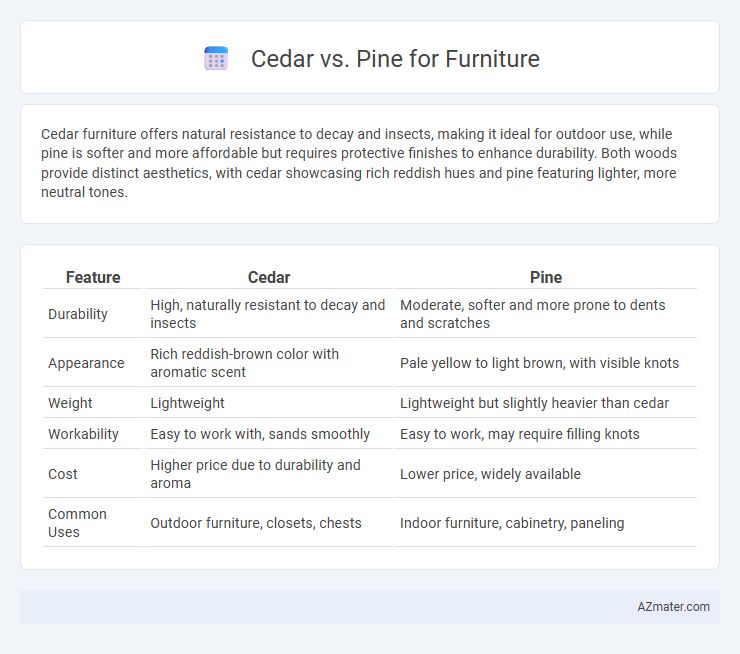Cedar furniture offers natural resistance to decay and insects, making it ideal for outdoor use, while pine is softer and more affordable but requires protective finishes to enhance durability. Both woods provide distinct aesthetics, with cedar showcasing rich reddish hues and pine featuring lighter, more neutral tones.
Table of Comparison
| Feature | Cedar | Pine |
|---|---|---|
| Durability | High, naturally resistant to decay and insects | Moderate, softer and more prone to dents and scratches |
| Appearance | Rich reddish-brown color with aromatic scent | Pale yellow to light brown, with visible knots |
| Weight | Lightweight | Lightweight but slightly heavier than cedar |
| Workability | Easy to work with, sands smoothly | Easy to work, may require filling knots |
| Cost | Higher price due to durability and aroma | Lower price, widely available |
| Common Uses | Outdoor furniture, closets, chests | Indoor furniture, cabinetry, paneling |
Introduction: Cedar vs Pine for Furniture
Cedar and pine are popular wood choices for furniture due to their durability and aesthetic appeal. Cedar offers natural resistance to decay and insects, making it ideal for outdoor furniture, while pine is valued for its affordability and ease of customization. Both woods provide distinct grain patterns and tones that influence the style and functionality of furniture pieces.
Wood Characteristics: Cedar and Pine
Cedar wood is renowned for its natural resistance to decay, insects, and moisture, making it ideal for outdoor furniture and environments prone to humidity. Pine, a softer wood, offers a lighter color and smooth grain, which can be easily painted or stained, but it is more susceptible to dents and scratches over time. Both woods vary in durability and aesthetic appeal, with cedar providing longevity and aromatic properties, while pine offers affordability and versatility in finishing options.
Durability and Longevity Comparison
Cedar offers superior resistance to moisture, insects, and decay, making it highly durable for both indoor and outdoor furniture. Pine is softer and more prone to dents, scratches, and wear, which reduces its lifespan compared to cedar. Cedar's natural oils contribute to its longevity, often lasting decades longer than untreated pine in similar conditions.
Appearance and Grain Differences
Cedar furniture boasts a rich, warm reddish hue with a fine, straight grain pattern that often features knots for a rustic aesthetic, while pine displays a lighter yellow to pale cream color with more prominent knots and a varied grain ranging from straight to wavy. Cedar's tight grain offers a smooth, consistent surface, ideal for detailed finishes, whereas pine's open grain provides a more pronounced texture that can emphasize natural imperfections. These visual distinctions make cedar suited for sophisticated, elegant furniture pieces, contrasting with pine's casual, farmhouse-style appeal.
Weight and Workability
Cedar furniture is notably lighter than pine, making it easier to move and handle during construction and maintenance. Pine's denser structure offers greater resistance to dents but can be more challenging to shape and sand compared to cedar's softer, more workable grain. Both woods are popular for furniture, yet cedar's lightweight nature and smooth workability make it a preferred choice for intricate designs and portability.
Resistance to Pests and Decay
Cedar wood offers superior resistance to pests and decay due to its natural oils and tannins that repel insects and prevent fungal growth, making it ideal for outdoor and moisture-prone furniture. Pine, while more affordable and widely available, is softer and more susceptible to damage from insects and rot unless treated with preservatives. Choosing cedar ensures longer-lasting furniture with minimal maintenance, especially in humid or pest-prone environments.
Cost and Affordability Analysis
Cedar furniture typically costs more than pine due to its natural resistance to rot, insects, and weather, which increases its durability and lifespan. Pine is more affordable and widely available, making it a budget-friendly option for indoor furniture, though it requires more maintenance and treatments to enhance longevity. Choosing between cedar and pine often depends on balancing upfront cost with long-term value, especially for outdoor or high-use environments.
Environmental Impact and Sustainability
Cedar furniture is favored for its natural resistance to decay and insects, reducing the need for chemical treatments and extending product lifespan, which supports sustainable use. Pine grows faster and requires less energy-intensive processing, making it a more renewable option with lower carbon emissions during harvesting and production. Both woods offer eco-friendly choices, but cedar's durability and pine's rapid growth rate are key factors in evaluating their environmental impact.
Best Furniture Applications
Cedar is ideal for outdoor furniture due to its natural resistance to moisture, decay, and insect damage, making it perfect for decks, patio sets, and garden benches. Pine, being softer and more affordable, is commonly used for indoor furniture like bookshelves, tables, and cabinets where less exposure to the elements occurs. Both woods offer distinct aesthetic qualities, with cedar providing a rich, aromatic finish and pine offering a light, versatile appearance suitable for various interior styles.
Final Verdict: Choosing Cedar or Pine
Cedar furniture offers superior durability, natural insect resistance, and a pleasant aroma, making it ideal for outdoor or rustic indoor pieces, while pine provides a cost-effective, lightweight option with a smooth finish suitable for painted or stained furniture. Pine's softer wood makes it easier to work with but more prone to dents and scratches compared to cedar's firmer grain. For long-lasting, weather-resistant furniture with natural beauty, cedar is preferable; for budget-friendly, versatile indoor furnishings, pine remains a practical choice.

Infographic: Cedar vs Pine for Furniture
 azmater.com
azmater.com